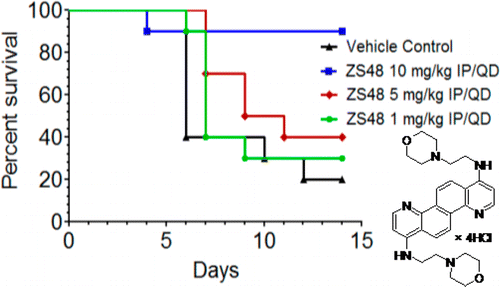Experimental Ebola treatment boosts survival in mice

The number of new Ebola cases is tapering off, but the search for new treatments continues. Now, one research team has found potential drug candidates that successfully treated up to 90 percent of mice exposed to the Ebola virus. They report their findings in the journal ACS Infectious Diseases.
Bogdan A. Solaja, Rekha G. Panchal and colleagues note that the U.S. Food and Drug Administration has yet to approve any therapeutic drugs or vaccines against the Ebola virus that, since December 2013, has infected more than 25,000 people and taken the lives of more than 10,000. While some researchers are developing vaccines to prevent Ebola infections, others are focusing on treatments for the disease. They are investigating a number of compounds, including existing malaria and flu drugs. Solaja's team has been looking into possible treatments by studying a class of small molecules called diazachrysenes, which they've found in lab tests to be non-toxic and effective against the most potent bacterial toxin, botulinum neurotoxin. They wanted to screen this family of compounds for possible anti-Ebola drug candidates.
The researchers narrowed down their search to a handful of diazachrysenes. In their study, 70 to 90 percent of the mice that received one of three of the experimental compounds survived infection and didn't show any obvious side effects.
More information: Anti-Ebola Activity of Diazachrysene Small Molecules, ACS Infect. Dis., Article ASAP. DOI: 10.1021/acsinfecdis.5b00028
Abstract
Herein we report on a diazachrysene class of small molecules that exhibit potent antiviral activity against the Ebola (EBOV) virus. The antiviral compounds are easily synthesized, and the most active compounds have excellent in vitro activity (0.34–0.70 μM) and are significantly less lipophilic than their predecessors. The three most potent diazachrysene antivirals do not exhibit any toxicity in vivo and protected 70–90% of the mice at 10 mg/kg following EBOV challenge. Together, these studies suggest that diazachrysenes are a promising class of compounds for hit to lead optimization and as potential Ebola therapeutics.


















